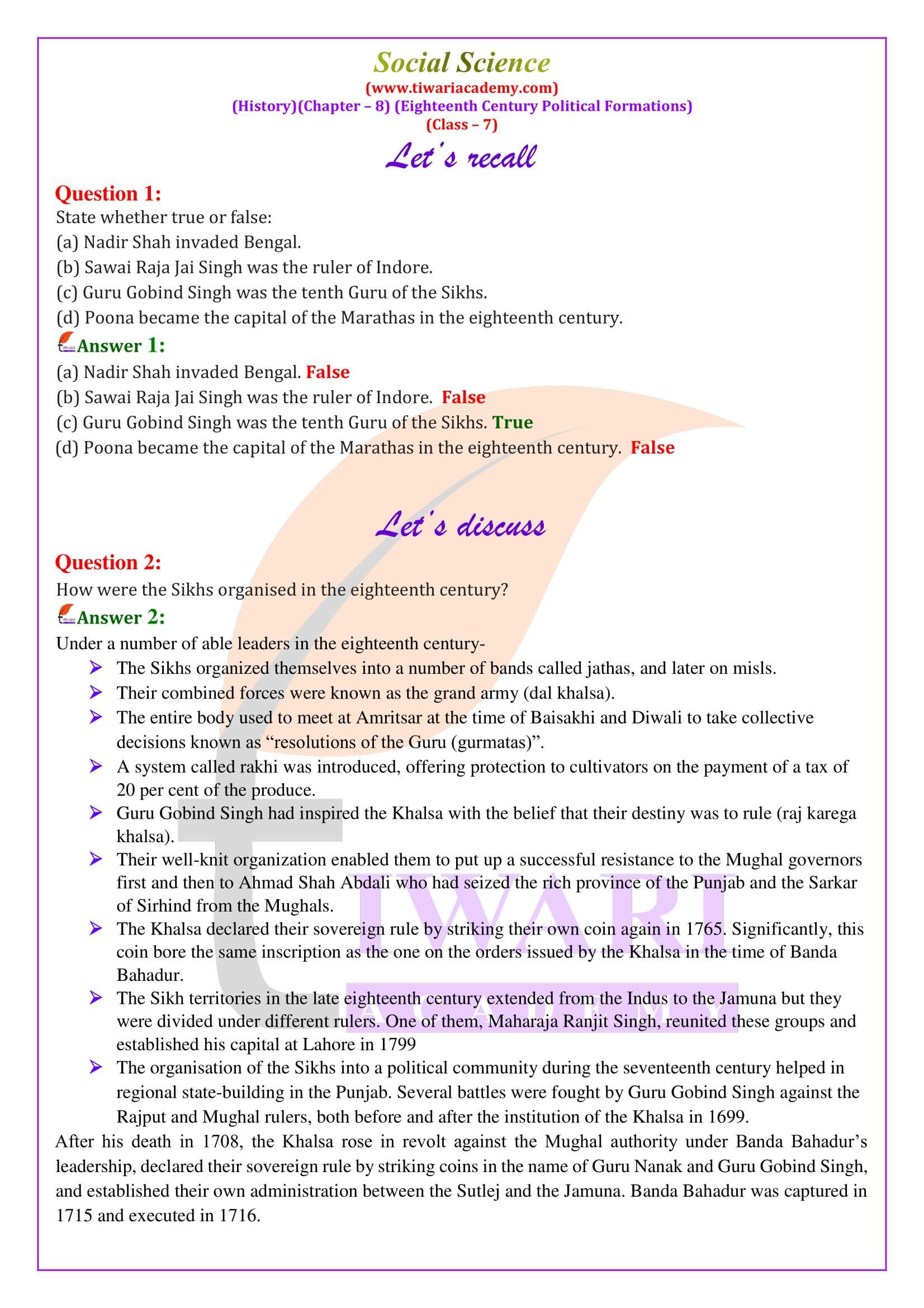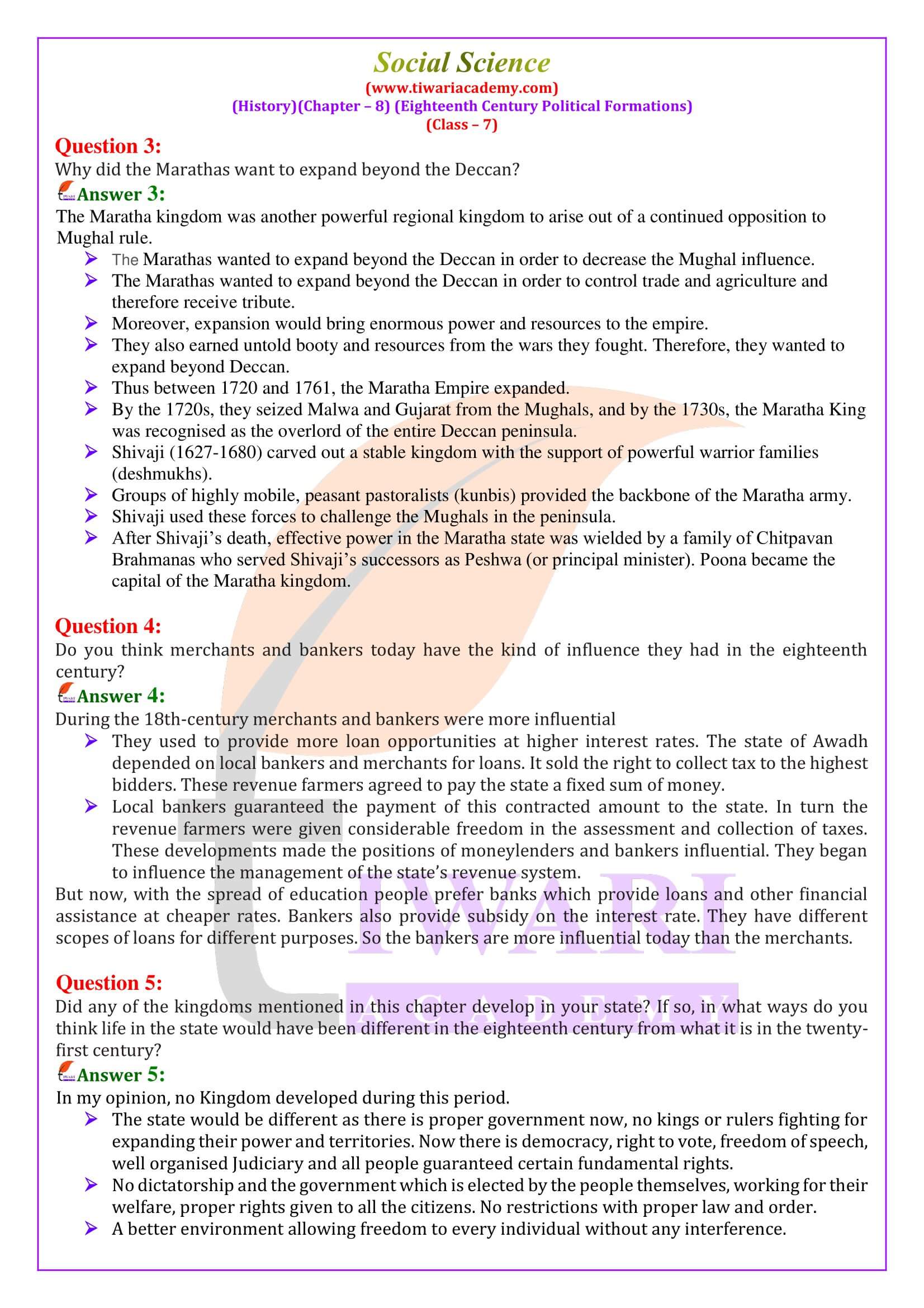NCERT Solutions for Class 7 Social Science History Chapter 8 Eighteenth Century Political Formations in English Medium and Hindi Medium free to View online or download in PDF for session 2024-25. Download NCERT Solutions App Updated for new academic session 2023–24. All the contents are in simplified format in online solutions as well as Offline Apps.
NCERT Solutions for Class 7 Social Science History Chapter 8
Class 7th History Chapter 8 Solution in Hindi and English
| Class: 7 | History |
| Subject: | Social Science |
| Chapter 8: | Eighteenth Century Political Formations |
| Academic Session: | 2024-25 |
| Medium: | Hindi and English |
Class 7 History Chapter 8 Question Answers
CBSE NCERT Solutions for Class 7 Social Science History Chapter 8 Eighteenth Century Political Formations in Hindi and English Medium is given here to use online or download in PDF for free. Download NCERT Solutions 2024-25 and Offline Online apps for new session 2024-25.
Class 7 History Chapter 8 in English Medium
Awadh state
Burhan-ul-Mulk Sa‘adat Khan was appointed subadar of Awadh in 1722 and founded a state which was one of the most important to emerge out of the break-up of the Mughal Empire. Awadh was a prosperous region, controlling the rich alluvial Ganga plain and the main trade route between north India and Bengal. Burhan-ul-Mulk also held the combined offices of subadari, diwani and faujdari.
Class 7 History Chapter 8 Extra Questions
What were the Crisis of the Empire and the Later Mughals?
Mughal Empire reached the height of its success and started facing a variety of crises towards the closing years of the seventeenth century. These were caused by a number of factors. Emperor Aurangzeb had depleted the military and financial resources of his empire by fighting a long war in the Deccan. Under his successors, the efficiency of the imperial administration broke down. It became increasingly difficult for the later Mughal emperors to keep a check on their powerful mansabdars.
What were the reason of Emergence of New States?
With the decline in the authority of the Mughal emperors, the governors of large provinces, subadars, and the great zamindars consolidated their authority in different parts of the subcontinent. Through the eighteenth century, the Mughal Empire gradually fragmented into a number of independent, regional states. Broadly speaking the states of the eighteenth century can be divided into three overlapping groups: (1) States that were old Mughal provinces like Awadh, Bengal and Hyderabad.
Who were the Watan Jagirs of the Rajputs?
Many Rajput kings, particularly those belonging to Amber and Jodhpur, had served under the Mughals with distinction. In exchange, they were permitted to enjoy considerable autonomy in their watan jagirs. In the eighteenth century, these rulers now attempted to extend their control over adjacent regions. Ajit Singh, the ruler of Jodhpur, was also involved in the factional politics at the Mughal court.
Class 7 Social Science – History Chapter 8 – Important Questions
What were the offices held by Sa‘adat Khan?
The offices held by Sa’adat Khan included subadari, diwani and faujdari.
Why did the Nawabs of Awadh and Bengal try to do away with the jagirdari system?
The Nawabs of Awadh and Bengal tried to do away with the jagirdari system because they wanted to prevent cheating as well as decrease the Mughal influence in their kingdoms.
How were the Sikhs organised in the eighteenth century?
In the eighteenth century, under a number of able leaders the Sikhs organized themselves into a number of bands called jathas, and later misls. Their combined forces were known as the grand army (dal khalsa). The entire body met at Amritsar during Baisakhi and Diwali to take collective decisions known as “resolutions of the guru (gurmatas)”. A system called rakhi was also introduced to offer protection to cultivators on the payment of a tax of 20 percent of the produce.
Why did the Marathas want to expand beyond the Deccan?
The Marathas wanted to expand beyond the Deccan to receive tribute as a way of accepting Maratha sovereignty and control trade and agriculture. Expansion also brought with it enormous resources.
What were the policies adopted by Asaf Jah to strengthen his position?
To strengthen his position Asaf Jah brought skilled soldiers and administrators from northern India. He also appointed mansabdars and granted jagirs. Although still a servant of the Mughal emperor he ruled independently without seeking any direction from Delhi or facing any interference.
Do you think merchants and bankers today have the kind of influence they had in the eighteenth century?
During the 18th century merchants were more influential the bankers. They used to provide more than enough loan opportunities at higher interest rates. But now, with the spread of education, people prefer banks which provide loans and other financial helps at cheaper rate. Bankers also provide subsidy on the interest rate. They have different scopes of loans for different purposes. So, they are more influential today than the merchants.
Important Notes on 7th History Chapter 8




